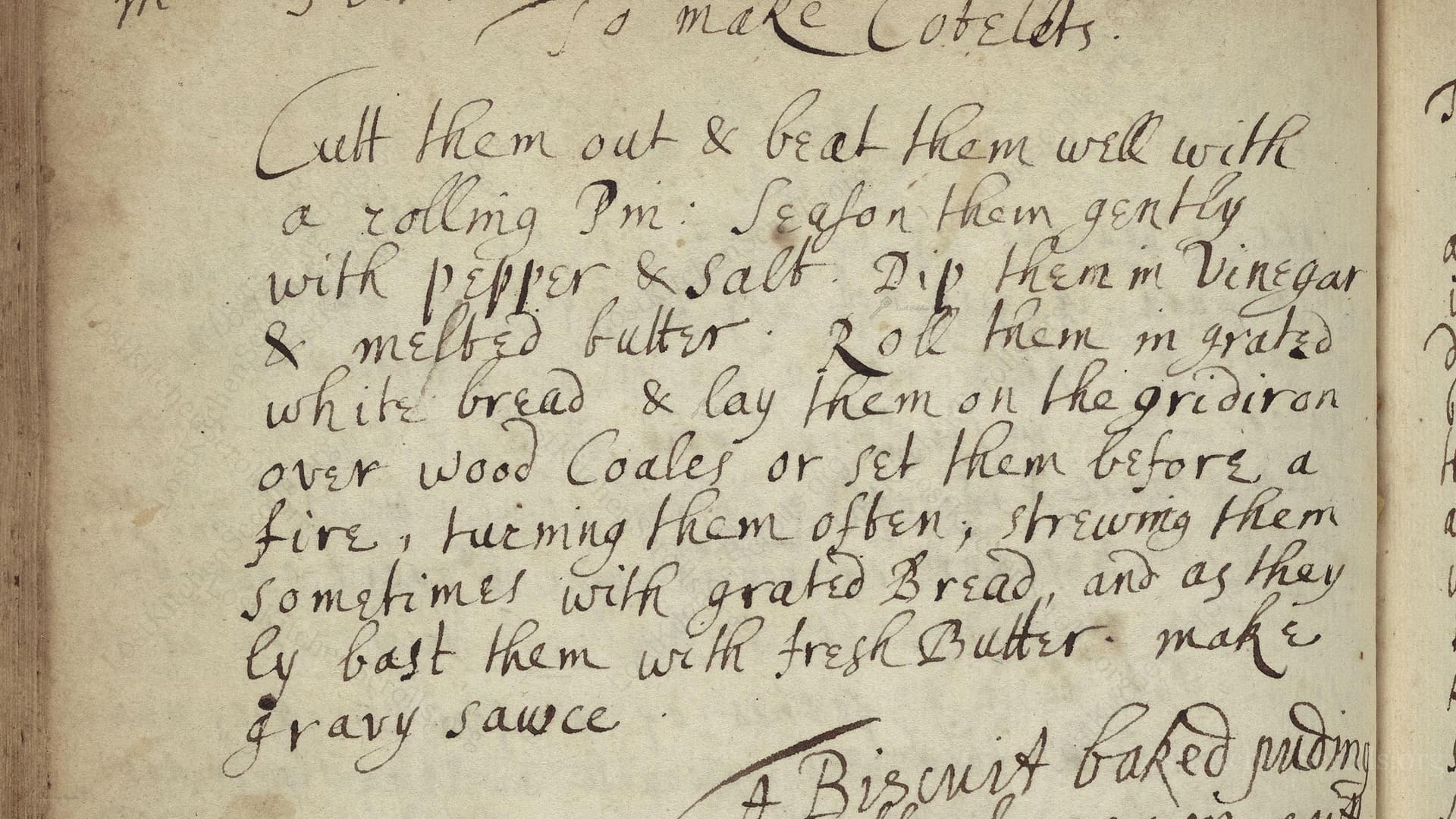To Make Cotelets
From the treasured pages of Receipt book of Penelope Jephson
Written by Penelope Patrick

To Make Cotelets
"Cutt them out & beat them well with a rolling Pin: Season them gently with pepper & Salt. Dip them in Vinegar & melted butterr. Roll them in grated white bread & lay them on the gridiron over wood Coales or set them before a fire, turning them often, strowing them sometimes with grated Bread, and as they ly bast them with fresh Butter. make gravy sauce"
Note on the Original Text
The recipe is written in the informal, imperatively structured style typical of manuscript cookbooks from the 17th century. Spelling is variable (e.g., 'Cotelets' instead of 'cutlets', 'Coales' for 'coals', 'strowing' for 'strewing'), and stepwise procedures lack precise weights, timings, or temperatures. Instead, the instructions rely on the skill and intuition of the cook, who is expected to season 'gently', turn 'often', and baste as needed. Such texts assume a working knowledge of domestic cookery and household fire management.

Title
Receipt book of Penelope Jephson (1673)
You can also click the book image above to peruse the original tome
Writer
Penelope Patrick
Era
1673
Publisher
Unknown
Background
Step back into the sumptuous kitchens of the late 17th century with Penelope Patrick’s culinary collection—a feast of historic recipes, secret tips, and the irresistible flavors of Restoration England all bound together in a handwritten treasure.
Kindly made available by
Folger Shakespeare Library
This recipe dates back to the late 17th century, found in the handwritten manuscript of Penelope Patrick, an English gentlewoman between 1671 and 1675. During this period, household recipe books were carefully maintained by women of the gentry and upper-middle classes, reflecting both practical cooking and the influence of courtly cuisine. Cutlets such as these—whether lamb or veal—were considered refined presentations of meat, suitable for both everyday dining and entertaining. The use of breadcrumbs, vinegar, and basting with butter echoes the beginnings of what would later become more formal techniques in French and English cookery. The method celebrates open-fire grilling, a hallmark of pre-industrial kitchens, and embraces the balance of tanginess and richness with the vinegar and butter pairing.

Cooks of the 17th century would have used a heavy rolling pin or wooden mallet to beat and tenderize the meat. The cutlets were grilled on a metal gridiron—an iron rack held over a wood or charcoal fire, or set before an open hearth. For making the simple gravy, a shallow pan or dripping tray would be used to catch and heat the meat juices. Basting brushes may have been bunches of herbs or feathers bound together. Simple knives, bread graters, and coarse cloths for straining or wiping would round out the kitchen arsenal—basic, practical, yet effective tools for robust, flavourful cookery.
Prep Time
15 mins
Cook Time
10 mins
Servings
4
We've done our best to adapt this historical recipe for modern kitchens, but some details may still need refinement. We warmly welcome feedback from fellow cooks and culinary historians — your insights support the entire community!
Ingredients
- 18–21 oz lamb or veal cutlets (about 4 cutlets, 3/8–1/2 inch thick)
- 1/2 tsp (about 1/16 oz) freshly ground black pepper
- 1 tsp (about 1/8 oz) fine sea salt
- 2 tbsp white wine vinegar
- 2 tbsp (about 1 oz) unsalted butter, melted (plus extra for basting)
- 1 cup (about 2 oz) fresh white breadcrumbs
- Optional: additional breadcrumbs for sprinkling
- For the gravy: use pan drippings, 1/3 cup (about 3 1/2 fl oz) stock (beef or chicken), 1 tbsp (about 1/3 oz) flour (optional to thicken)
Instructions
- Begin by selecting lamb or veal cutlets, trimming them to about 3/8–1/2 inch thick.
- Tenderize the cutlets with a meat mallet.
- Season each side gently with salt and freshly ground black pepper.
- In a shallow bowl, combine 2 tablespoons of white wine vinegar with 2 tablespoons of melted unsalted butter.
- Dip each cutlet thoroughly in the mixture.
- Next, coat them in fresh white breadcrumbs, ensuring an even layer.
- Preheat a grill or prepare a barbecue with wood charcoal if possible (otherwise, a gas grill works).
- Lay the cutlets on the grill, turning them often.
- Occasionally, sprinkle them with more breadcrumbs and baste with melted butter as they cook.
- Grill until the cutlets are golden and cooked through (about 8–10 minutes, depending on thickness).
- Serve with a simple pan gravy, made from the drippings, for added flavor.
Estimated Calories
350 per serving
Cooking Estimates
It takes about 15 minutes to get everything ready, and 10 minutes to cook the cutlets. Each serving is about 350 calories if you divide this recipe among 4 people.
As noted above, we have made our best effort to translate and adapt this historical recipe for modern kitchens, taking into account ingredients nowadays, cooking techniques, measurements, and so on. However, historical recipes often contain assumptions that require interpretation.
We'd love for anyone to help improve these adaptations. Community contributions are highly welcome. If you have suggestions, corrections, or cooking tips based on your experience with this recipe, please share them below.
Join the Discussion
Rate This Recipe

Den Bockfisch In Einer Fleisch Suppen Zu Kochen
This recipe hails from a German manuscript cookbook compiled in 1696, a time whe...

Die Grieß Nudlen Zumachen
This recipe comes from a rather mysterious manuscript cookbook, penned anonymous...

Ein Boudain
This recipe comes from an anonymous German-language manuscript cookbook from 169...

Ein Gesaltzen Citroni
This recipe, dating from 1696, comes from an extensive anonymous German cookbook...
Browse our complete collection of time-honored recipes



